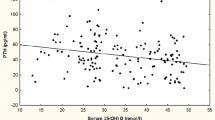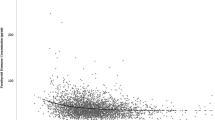Abstract
Optimal vitamin D concentrations for bone health have not been determined in the Korean population. The aim of this study was to define serum 25-hydroxyvitamin D (25[OH]D) concentrations that indicate insufficiency among older Korean adults as measured by serum intact parathyroid hormone (iPTH) concentrations and bone mineral density (BMD). We analyzed data from the Fourth Korea National Health and Nutrition Examination Survey (KNHANES IV-3), which was conducted in Korea in 2009. We enrolled 1,451 men and 1,870 women aged 49 years and above. After adjusting for variables that could potentially affect serum 25(OH)D concentrations, we found that serum iPTH concentrations began to increase at serum 25(OH)D concentrations below 12.1 ng/mL (30.2 nmol/L). In addition, total-femur BMD increased until serum 25(OH)D concentrations dropped below 20.4 ng/mL (50.9 nmol/L); no significant changes were observed thereafter. Assuming that serum 25(OH)D concentrations below 12.1 and 20.4 ng/mL represent vitamin D insufficiency, the prevalences of vitamin D insufficiency were 8.7 and 50.4 % in men and 17.9 and 66.3 % in women, respectively. Serum 25(OH)D cutoff values of 12.1 ng/mL (OR = 1.26) and 20.4 ng/mL (OR = 1.54) were associated with osteoporosis (P < 0.01); osteoporosis was not associated with a 25(OH)D cutoff value of 30 ng/mL (75.0 nmol/L). In conclusion, serum 25(OH)D concentrations of 20 ng/mL might be sufficient for bone health in older Korean adults.



Similar content being viewed by others
References
Lips P, Hosking D, Lippuner K, Norquist JM, Wehren L, Maalouf G, Ragi-Eis S, Chandler J (2006) The prevalence of vitamin D inadequacy amongst women with osteoporosis: an international epidemiological investigation. J Int Med 260:245–254
Holick MF (2007) Vitamin D deficiency. N Engl J Med 357:266–281
Holick MF (2006) High prevalence of vitamin D inadequacy and implications for health. Mayo Clin Proc 81:353–373
Bischoff-Ferrari HA, Giovannucci E, Willett WC, Dietrich T, Dawson-Hughes B (2006) Estimation of optimal serum concentrations of 25-hydroxyvitamin D for multiple health outcomes. Am J Clin Nutr 84:18–28
Malabanan A, Veronikis IE, Holick MF (1998) Redefining vitamin D insufficiency. Lancet 351:805–806
Thomas MK, Lloyd-Jones DM, Thadhani RI, Shaw AC, Deraska DJ, Kitch BT, Vamvakas EC, Dick IM, Prince RL et al (1998) Hypovitaminosis D in medical inpatients. N Engl J Med 338:777–783
Chapuy MC, Preziosi P, Maamer M, Arnaud S, Galan P, Hercberg S, Meunier PJ (1997) Prevalence of vitamin D insufficiency in an adult normal population. Osteoporos Int 7:439–443
Holick MF, Siris ES, Binkley N, Beard MK, Khan A, Katzer JT, Petruschke RA, Chen E, de Papp AE (2005) Prevalence of vitamin D inadequacy among postmenopausal North American women receiving osteoporosis therapy. J Clin Endocrinol Metab 90:3215–3224
Lips P (2001) Vitamin D deficiency and secondary hyperparathyroidism in the elderly: consequences for bone loss and fractures and therapeutic implications. Endocr Rev 22:477–501
Ross AC, Manson JE, Abrams SA, Aloia JF, Brannon PM, Clinton SK, Durazo-Arvizu RA, Gallagher JC, Gallo RL et al (2011) The 2011 report on dietary reference intakes for calcium and vitamin D from the Institute of Medicine: what clinicians need to know. J Clin Endocrinol Metab 96:53–58
Kanis JA (1994) Assessment of fracture risk and its application to screening for postmenopausal osteoporosis: synopsis of a WHO report. WHO Study Group. Osteoporos Int 4:368–381
Institute of Medicine (1997) Dietary reference intakes for calcium, phosphorus, magnesium, vitamin D, and fluoride. National Academies Press, Washington DC
Heaney RP, Dowell MS, Hale CA, Bendich A (2003) Calcium absorption varies within the reference range for serum 25-hydroxyvitamin D. J Am Coll Nutr 22:142–146
Bolland MJ, Grey AB, Ames RW, Mason BH, Horne AM, Gamble GD, Reid IR (2007) The effects of seasonal variation of 25-hydroxyvitamin D and fat mass on a diagnosis of vitamin D sufficiency. Am J Clin Nutr 86:959–964
Steingrimsdottir L, Gunnarsson O, Indridason OS, Franzson L, Sigurdsson G (2005) Relationship between serum parathyroid hormone levels, vitamin D sufficiency, and calcium intake. JAMA 294:2336–2341
Kanis JA, Johnell O, De Laet C, Jonsson B, Oden A, Ogelsby AK (2002) International variations in hip fracture probabilities: implications for risk assessment. J Bone Miner Res 17:1237–1244
Sai AJ, Walters RW, Fang X, Gallagher JC (2011) Relationship between vitamin D, parathyroid hormone, and bone health. J Clin Endocrinol Metab 96:E436–E446
Rosen CJ (2011) Clinical practice. Vitamin D insufficiency. N Engl J Med 364:248–254
Ensrud KE, Taylor BC, Paudel ML, Cauley JA, Cawthon PM, Cummings SR, Fink HA, Barrett-Connor E, Zmuda JM et al (2009) Serum 25-hydroxyvitamin D levels and rate of hip bone loss in older men. J Clin Endocrinol Metab 94:2773–2780
Nakamura K, Nashimoto M, Tsuchiya Y, Saito T, Nishiwaki T, Ueno K, Okuda Y, Oshiki R, Yamamoto M (2006) Threshold value of serum 25-hydroxyvitamin D concentration in relation to elevated serum parathyroid hormone concentrations in elderly Japanese women. J Bone Miner Metab 24:395–400
Priemel M, von Domarus C, Klatte TO, Kessler S, Schlie J, Meier S, Proksch N, Pastor F, Netter C et al (2010) Bone mineralization defects and vitamin D deficiency: histomorphometric analysis of iliac crest bone biopsies and circulating 25-hydroxyvitamin D in 675 patients. J Bone Miner Res 25:305–312
Poole KE, Compston JE (2006) Osteoporosis and its management. BMJ 333:1251–1256
Raso AA, Navarra SV, Li-Yu J, Torralba TP (2009) Survey of vitamin D levels among post-menopausal Filipino women with osteoporosis. Int J Rheum Dis 12:225–229
Acknowledgments
This study was performed using raw data from the Fourth Korea National Health and Nutrition Examination Survey (KNHANES IV), which was conducted by the Korean Centers for Disease Control and Prevention. This study was supported in part by a grant from the Clinical Research Institute, Kyung Hee University Hospital at Gangdong, in 2010 (KHNMCCRI-2010-001).
Author information
Authors and Affiliations
Corresponding author
Additional information
The authors have stated that they have no conflict of interest.
Rights and permissions
About this article
Cite this article
Hwang, YC., Ahn, HY., Jeong, IK. et al. Optimal Serum Concentration of 25-Hydroxyvitamin D for Bone Health in Older Korean Adults. Calcif Tissue Int 92, 68–74 (2013). https://doi.org/10.1007/s00223-012-9669-3
Received:
Accepted:
Published:
Issue Date:
DOI: https://doi.org/10.1007/s00223-012-9669-3




